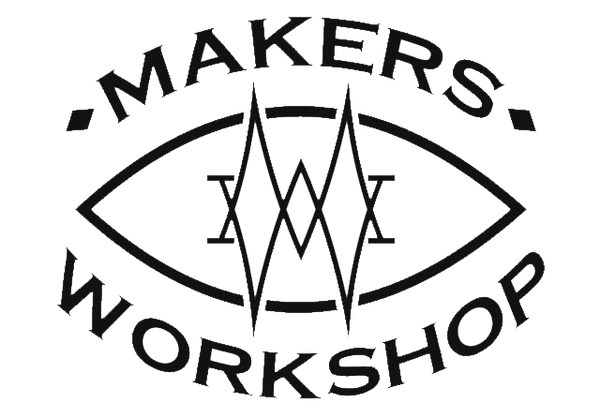I wanted the finished table to be about 44 inches long, so I cut two slabs of cherry to 48 inches with my circular saw to allow room for trimming later on. After cutting my pieces, I brought them over to the drum sander and flattened both faces.
Next, I eliminated all the bark with the draw knife and then went back with the rotary sander on a 180 grit to clean up the rest of the edges. Then I repeated the process on the other three sides.
I then created a mold by cutting a piece of half-inch plywood to length and coating the entire surface with Tyvek tape. I made sure to overlap the tape by a quarter of an inch so the resin wouldn’t leak out.
For the sides, I used some spare 2x3s, cut them in half, and re-sawed them on the bandsaw to give me two thin pieces. I then coated those with Tyvek tape as well. After I had the mold together, I went back and coated all of the inside seals with an additional piece of Tyvek tape. I also sealed the corners really well with hot glue.
The next step was to prepare the pieces for the resin. I laid the slabs out into the mold, I leveled it, and clamped it to the table so that it wouldn’t move.
Then I mixed up the first small batch of resin using EcoPoxy. I painted the edges to seal them with the clear. I wanted to test out the perfect pale blue for the resin river by adding just one drop of alcohol ink at a time to see the result. I poured this as a very, very thin layer into the tabletop. And the next day, it was time for the big pour.
After letting the resin sit for about a week, it was time to remove the tabletop from the mold using a pry bar and a hammer. It came out great!
I put the tabletop on the drum sander on a coarse grit to quickly remove the excess resin, and then I filled in some holes with TotalBoat 2:1. After that cured, I went back to the drum sander on a finer grit to remove the excess.
It was then time to weld the base. I started by trimming the edges of the pieces so I had a flat starting point. Then I measured and cut all of my pieces to length using a chop saw. Next, I went in with my angle grinder to flatten the bottoms and add a taper to each piece of metal. I then squared my pieces and tack welded the base together.
Then I went back in and welded my seams completely around. Next, I went in with the angle grinder again and flattened out all of my seams.
I had a few pinholes after welding, so I mixed up a little bit of Bondo and used my finger to smush it into the areas with pinholes. I sanded the Bondo down and then sanded the full piece before spray-painting it with a filler primer.
Next, I set to work on the shelf. I cut one four-foot section off of a slab and removed the live edge on one side. I then ran it through the drum sander to flatten it and also removed the bark. Then I passed the flat edge through the joiner to give me a nice flat surface, and I resawed it right down the middle using the bandsaw.
After letting it sit overnight, it was time to unclamp the shelf. Then I passed the entire shelf through the drum sander to get a completely flat finished piece.
At this point, part of the metal frame was passing over the river, so I cut out the middle section of the frame so that it wouldn’t show through the clear epoxy. To drill the mounting holes, I first drilled the pilot holes using a small bit, and then I used a step bit to widen the holes.
Next, I marked the final size I wanted for both my shelf and the tabletop and trimmed them down with a circular saw. Once everything was positioned correctly, I painted the frame black.
Then I sanded the wood on the tabletop to a 220 grit, and I brought the resin up to a 2000 grit using a random orbital sander. I also cleaned off the dust using a rag and some paint thinner. This is an important step before the finish goes on.
At that point, it was time for the finish using Osmo, a hard wax oil finish. I did about three coats to get my desired finished look, and I then coated the shelf to match.
Then it was time to mount everything together. I used the center line and made sure that that was lined up with the center hole. I drilled pilot holes, being sure not to go all the way through the board because the shelf was pretty thick.
I then repositioned the shelf and screwed it in with a hand screwdriver. Next, I laid the tabletop down, positioning it carefully before marking my holes and screwing that piece to the base.
This was my first resin river table and I’m super happy with how it came out. I love the finish, I love the way that the blue contrasts with the cherry, and I think that I will definitely be making more of these!
